Once the summer heat arrives smartweeds appear. These are common, weedy plants that are widespread, easy to identify and have no poisonous look a-likes. Some smartweeds are used as an herb or a spicy seasoning, while others like lady's thumb make a decent vegetable. In this post we'll go over the basics of how to identify, harvest and cook with them.
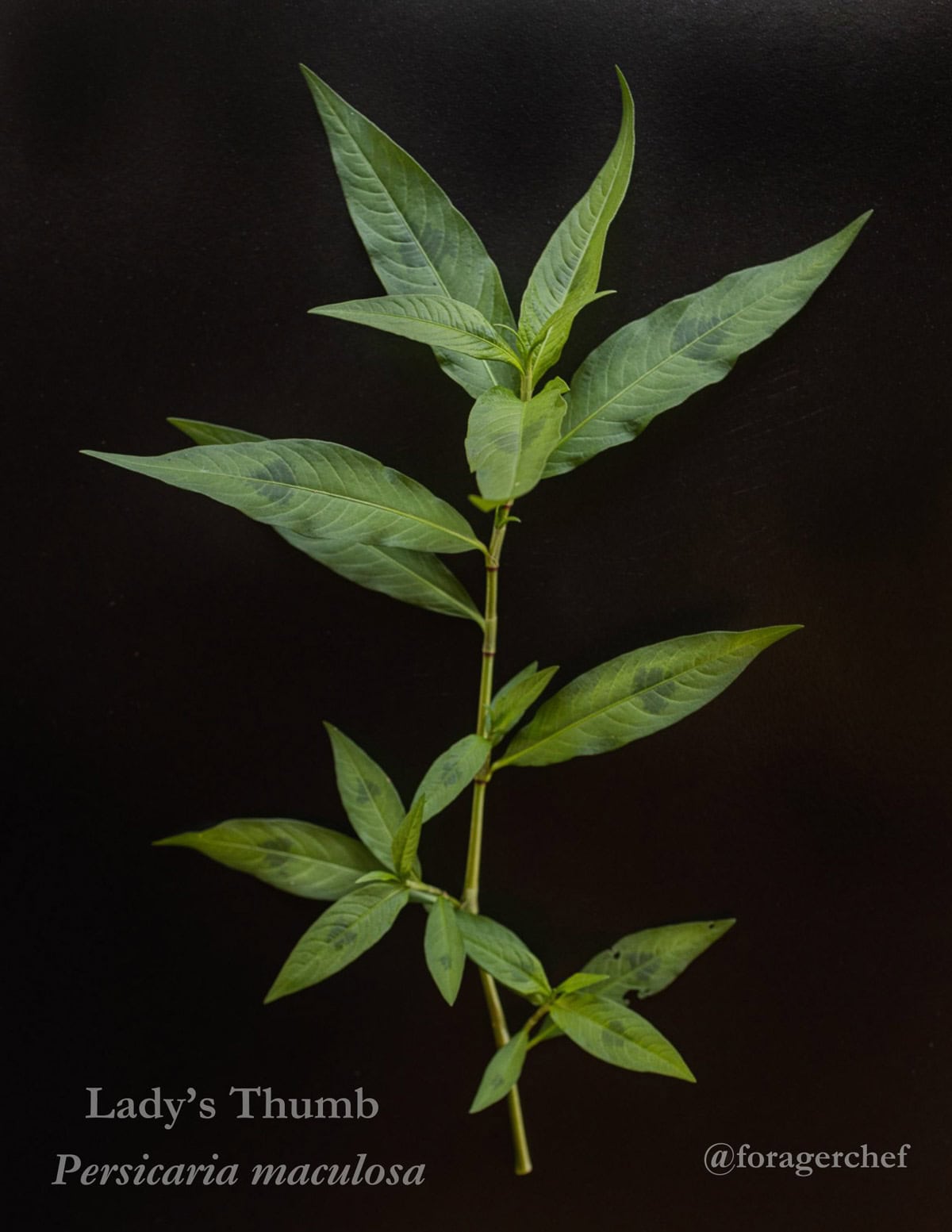
Background: The Genus Persicaria
Smartweeds are in the buckwheat / knotweed family (Polygonaceae) making them cousins of dock and Japanese knotweed.
There's lot of plants in the genus Persicaria, some are native like dock-leaved smartweed (Persicaria lapathifolia), many others are not. These plants are widespread across North America, easily spotted by their small pink or white flower spikes, and stems that look like miniature bamboo.

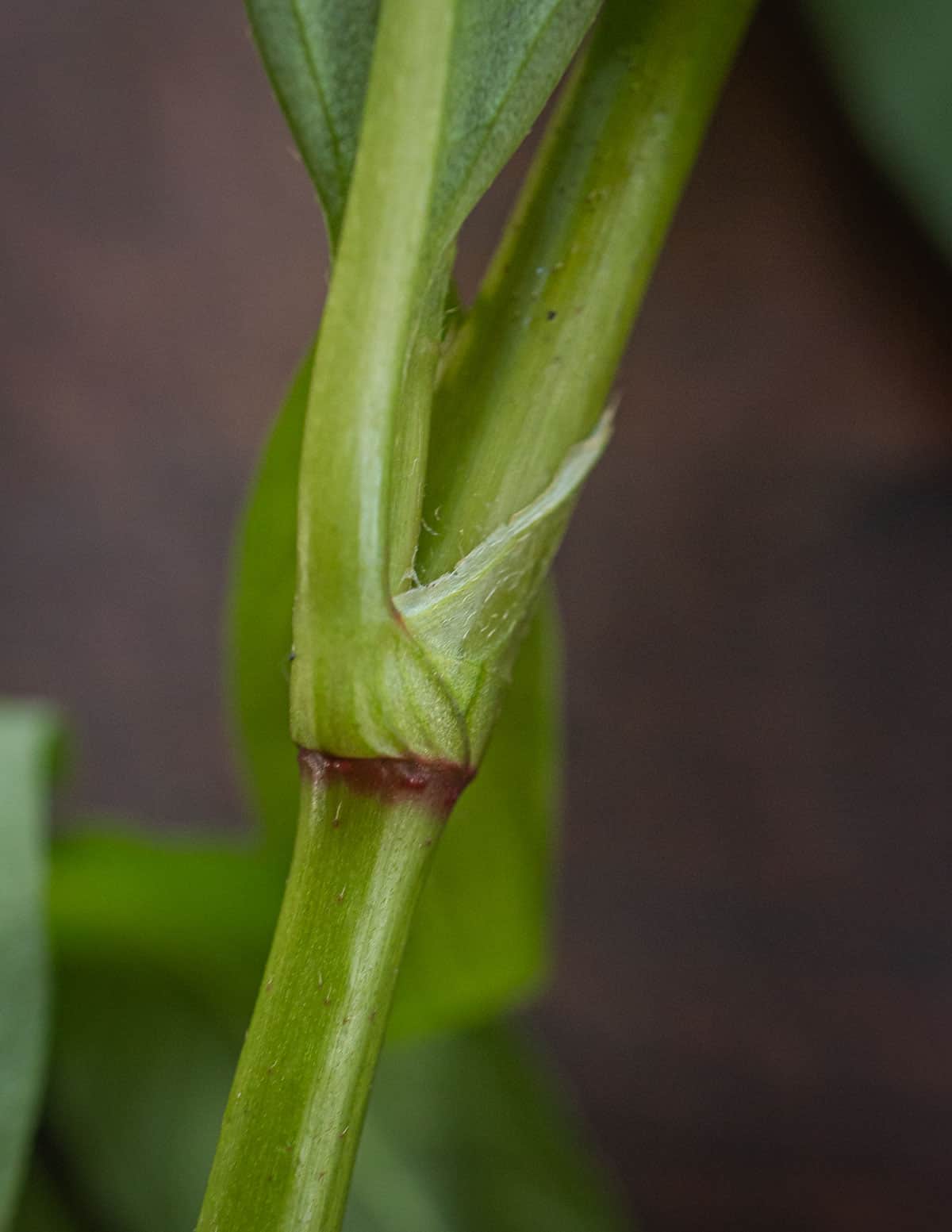
Where other groups of related plants taste pretty similar, Persicarias have a variety of flavors and aromas. All smartweeds are edible, but there can be drastic differences between species. Some are herbs, some are spicy hot, and some are simply vegetables. I'll briefly go over two distinct varieties below.
Waterpepper
With a taste like mild cilantro crossed with wasabi, waterpepper (Persicaria hydropiper) is the plant smartweeds are named for, and touching sensitive parts of your body after handling them can be just as unpleasant as the capsaicin of a hot pepper.
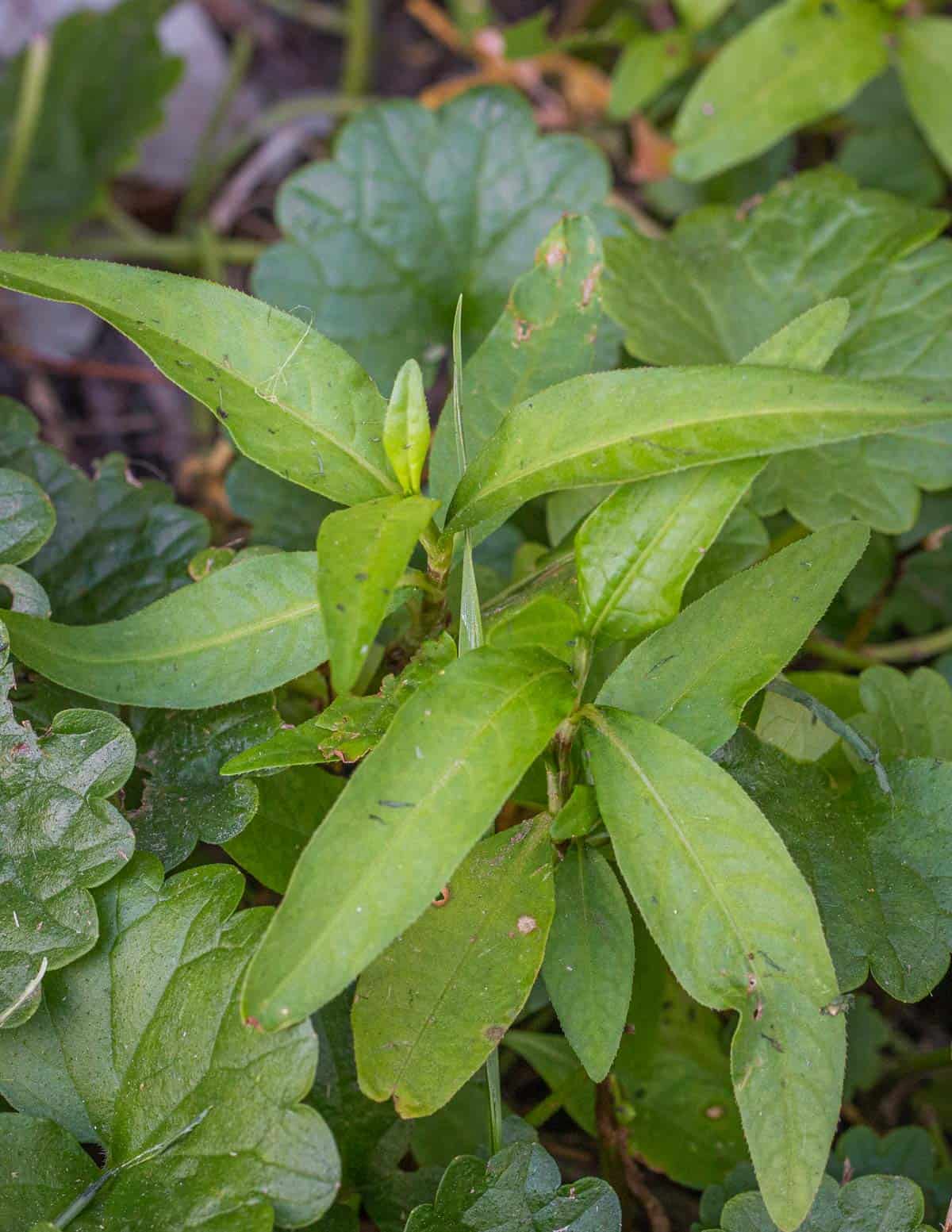
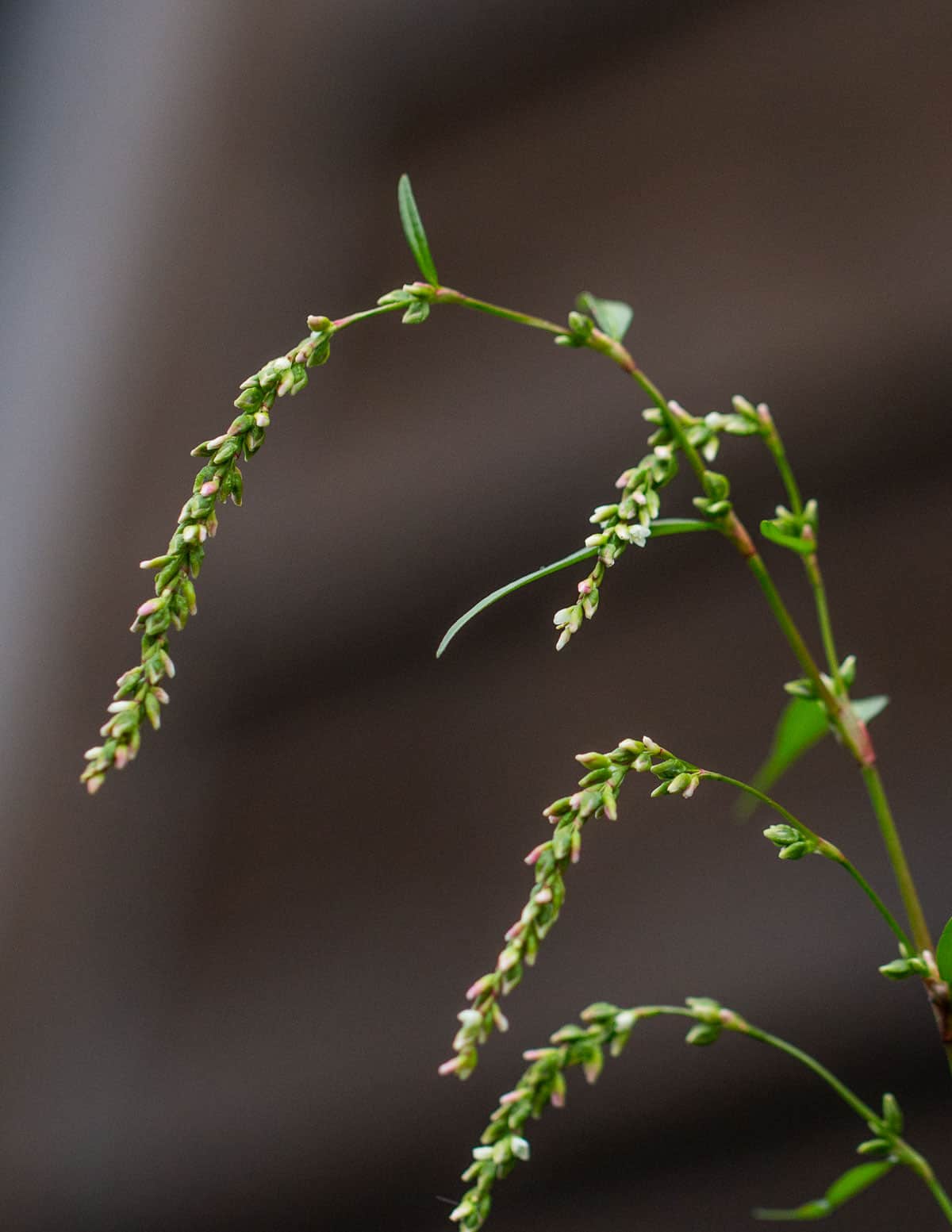
In his new field guide, Sam Thayer writes that Warburganal is the compound primarily responsible for the spicy taste. Waterpepper leaves and seeds are remarkably spicy and it's used to make a traditional sauce called Tade Su in Japan. Sam Thayer mentions that Persicaria punctata is also spicy but I haven't tried it yet.
Rau Ram (Persicaria odorata)
As the name implies, Persicaria odorata is aromatic. Also known as rau ram, pak-pew leaf and Vietnamese coriander, it tastes a bit like cilantro with a subtle, spicy finish. It's probably the best cilantro substitute I know besides culantro. If you're one of the unfortunate people who can't tolerate cilantro you'll want to stay far, far away from both waterpepper and Rau Ram.
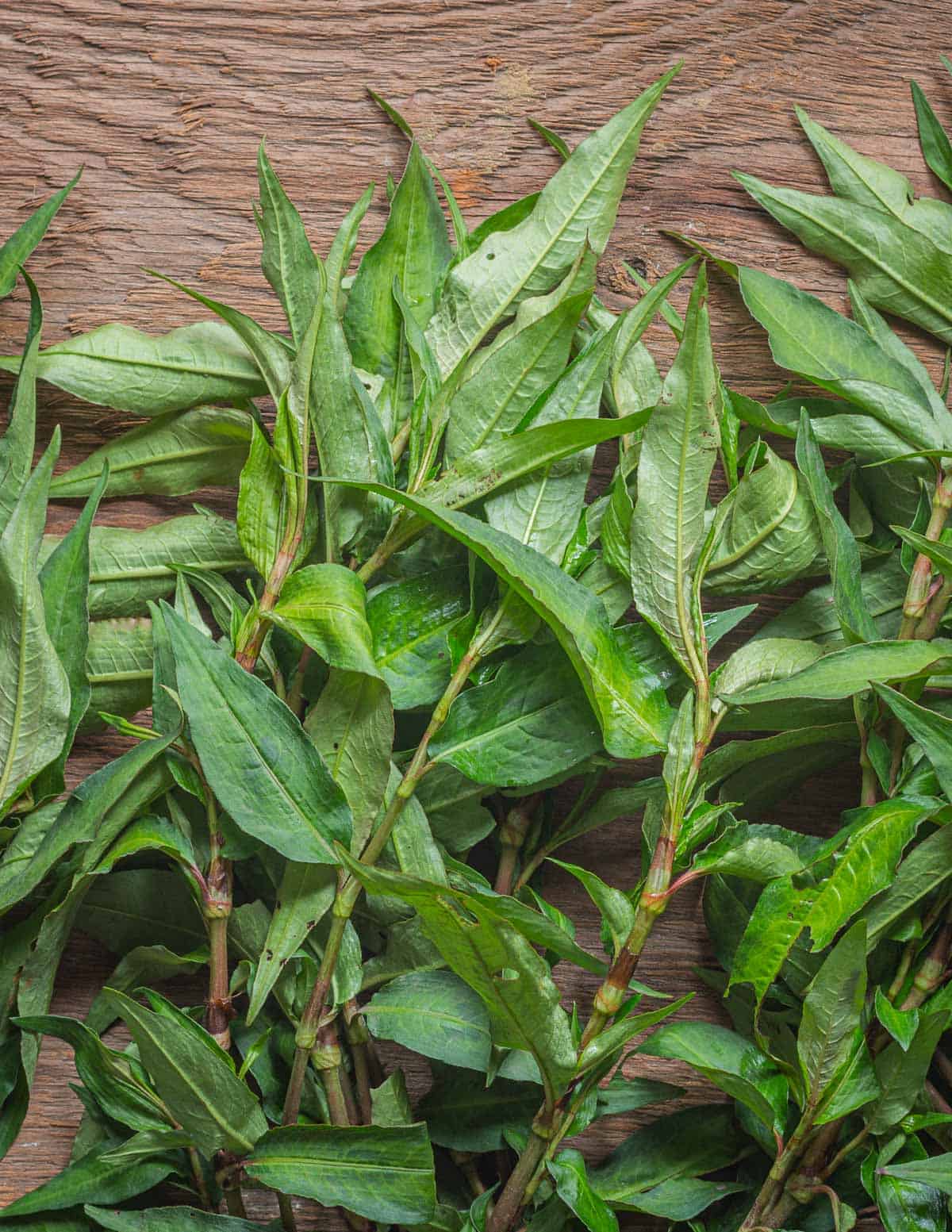
I love it used in green sauces, stir fries, and mixed with other summer herbs. A Hmong farmer tipped me off on the traditional use of the herb to flavor a cooked chicken salad eaten with rice.

Finally there's lady's thumb and a few others like dock leaved smartweed that are mild tasting and make a good vegetable.
Lady's Thumb Identification
Native to Europe and also known by the name red shanks, lady's thumb (and other smartweeds) are summer annuals that seem to appear the instant the soil warms up around June in Minnesota.
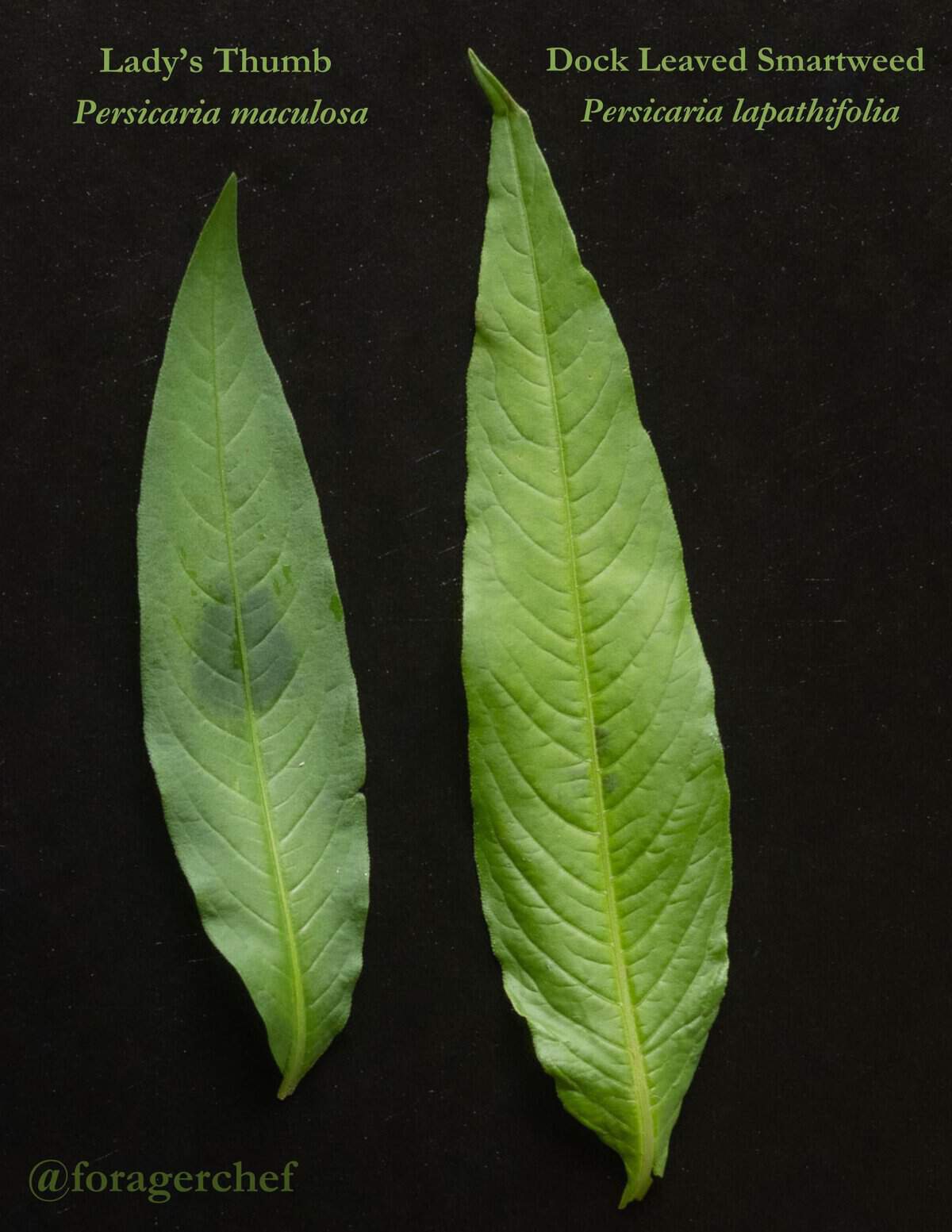
There are many smartweeds, but the dark spot on upper surface of the leaf is a dead giveaway it's good species for eating, although some plants may not show it like the dock leaved smartweed above.
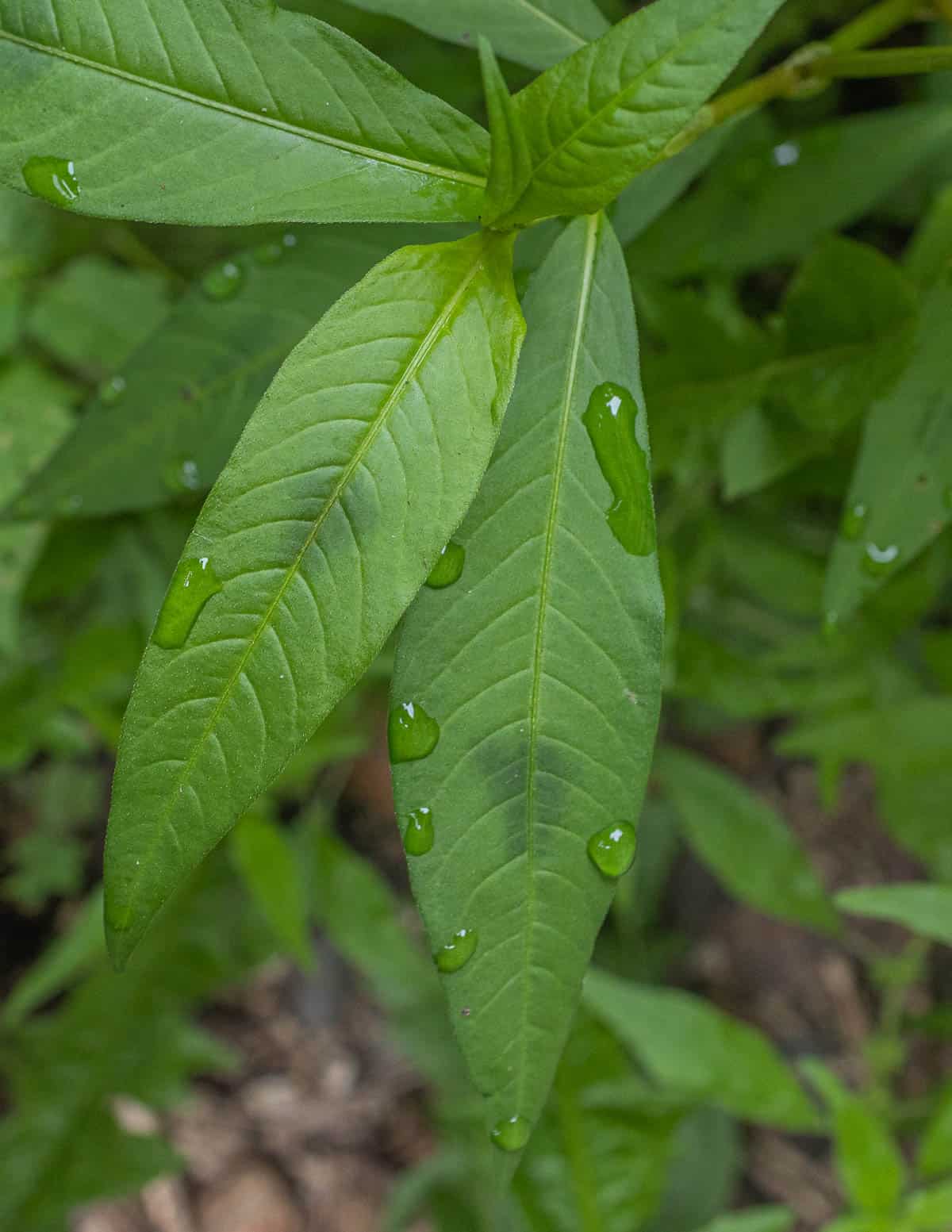
Lady's thumb is one of the most common smartweeds, but it can be confusing to identify as it has overlapping characteristics with a few others, especially Persicaria pennsylvanica. Thankfully all smartweeds are edible and will probably taste ok to most people.
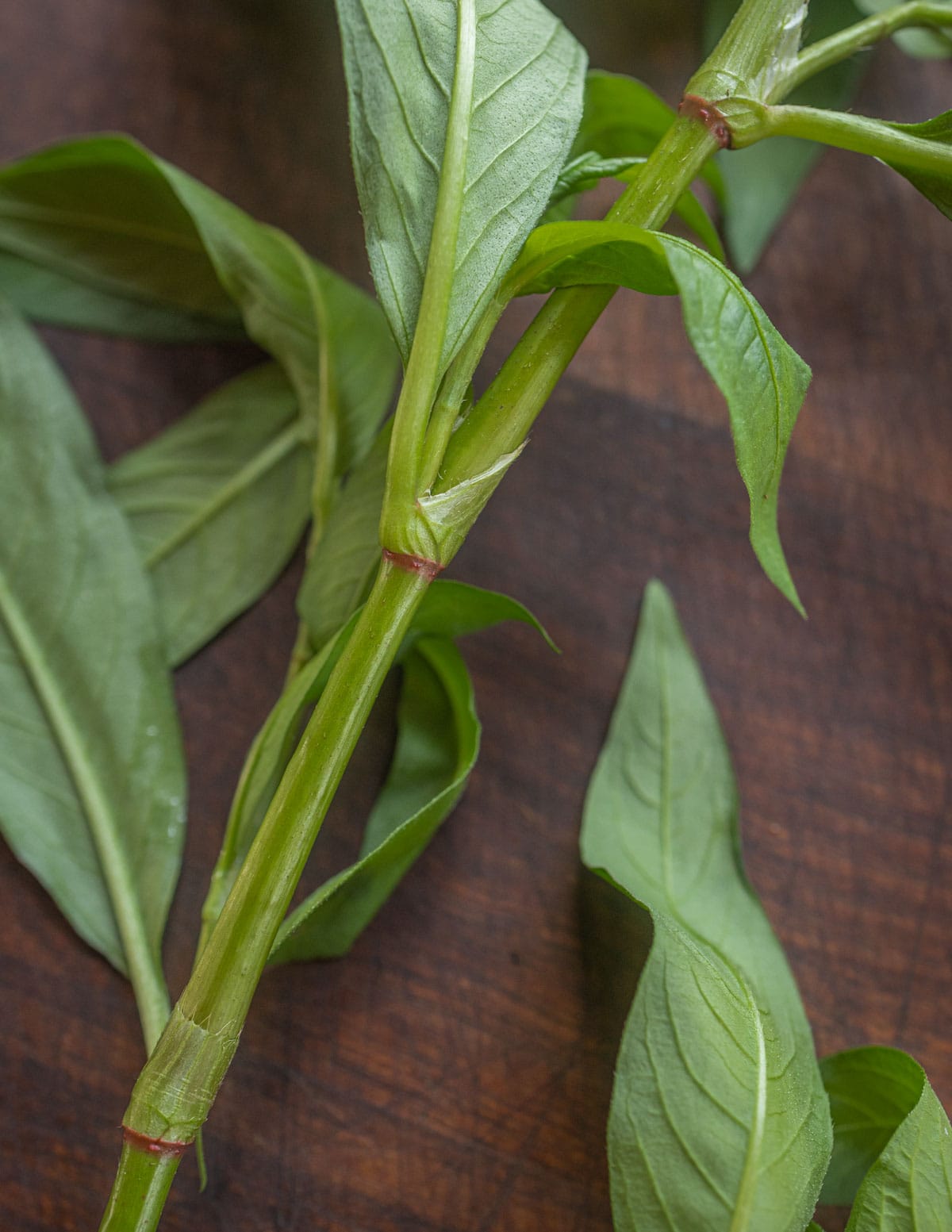
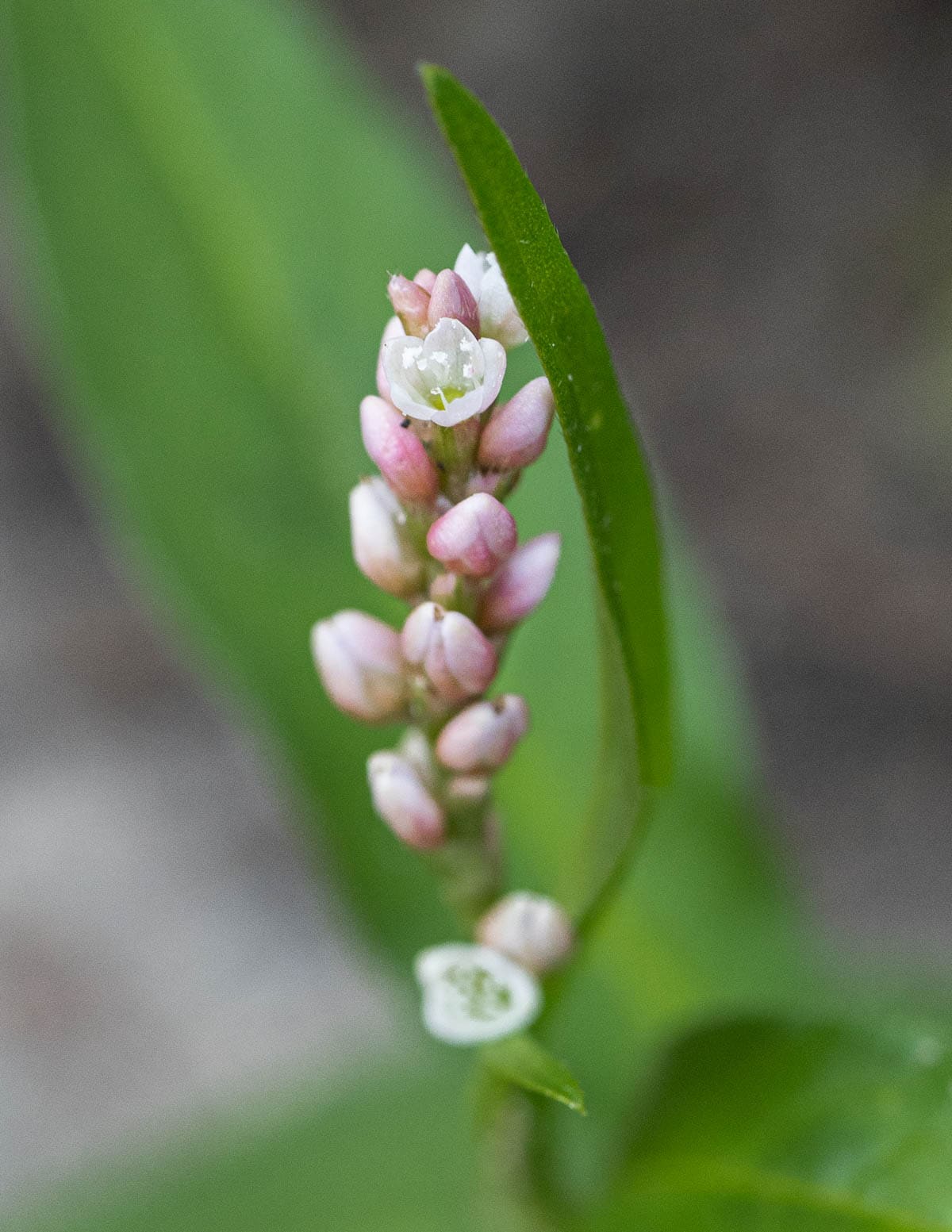
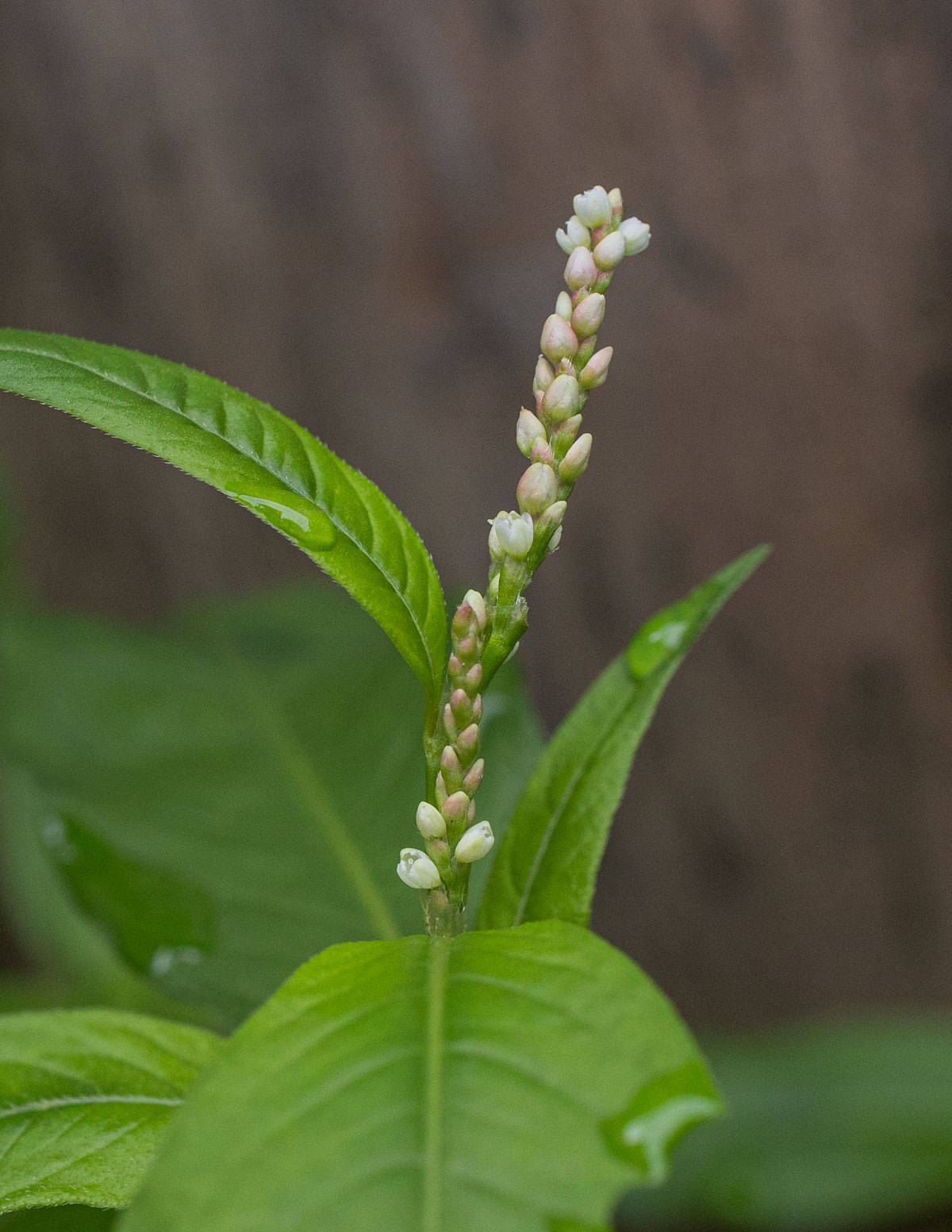
Here's the most helpful notes I have on identifying Lady's thumb:
Pennsylvania Smartweed vs Lady's Thumb
- The easiest way to tell the two plants apart is that lady's thumb has visible bristles or cilia on the sheath (ocrea) where Pennsylvania smartweed and dock leaved smartweed usually don't. See the infographic below-the hairs are miniscule (and hard to photograph).
- Lady's thumb almost always have a dark blotch or marking on the leaf, which will fade as the plant makes flowers.
- The flowers can be pink or white.
- Pennsylvania smartweed can sometimes have a dark blotch on the leaf, but Lady's thumb almost always will.
- The dark blotch on the leaf can appear as an asymmetrical blob, or as more of a pointed chevron.
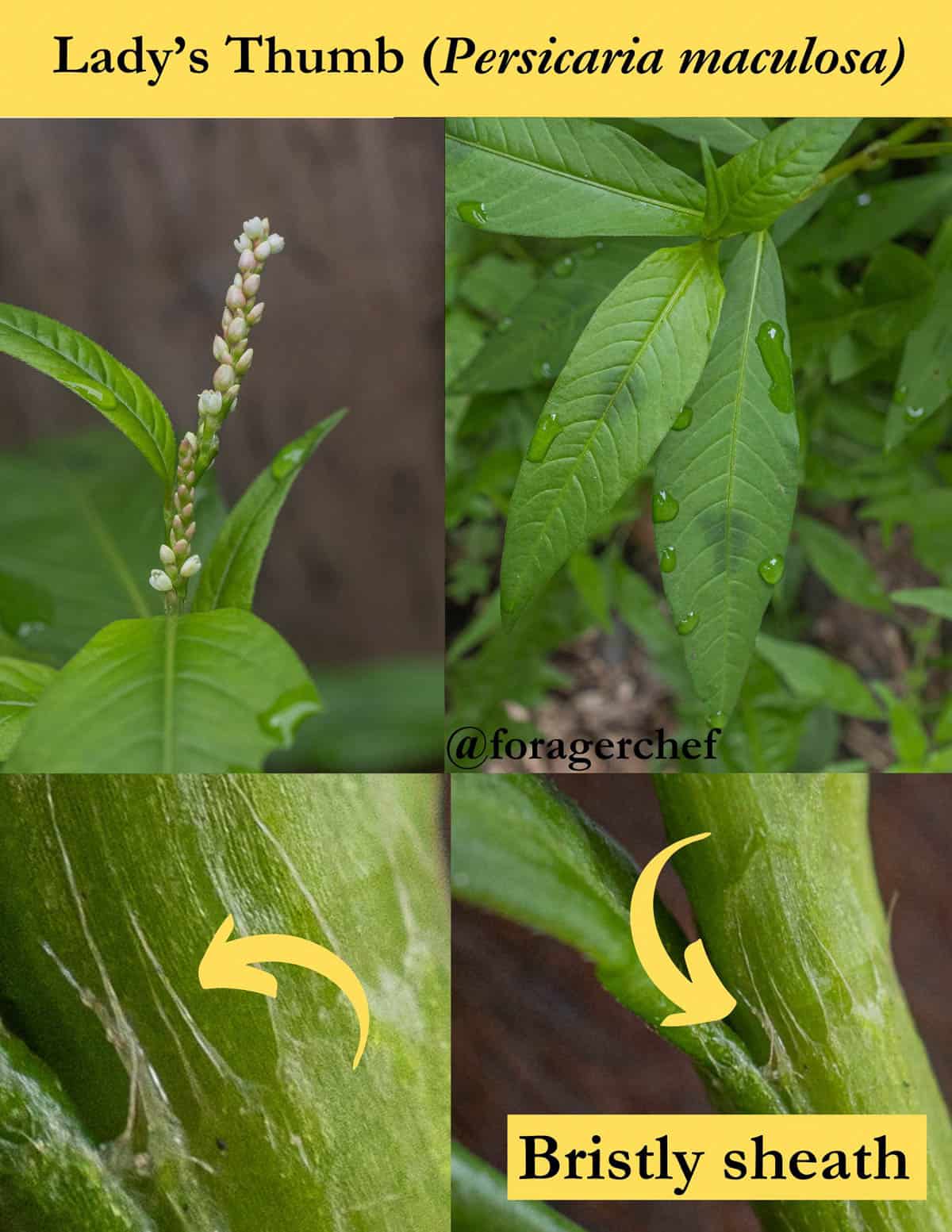
Like some of its cousins, Lady's thumb can do very well in disturbed areas, gardens, vacant lots and places weeds grow, but I see the lushest plants in washed out areas and moist soils that occasionally hold water. They love growing in the washed out portion of my boulevard garden.
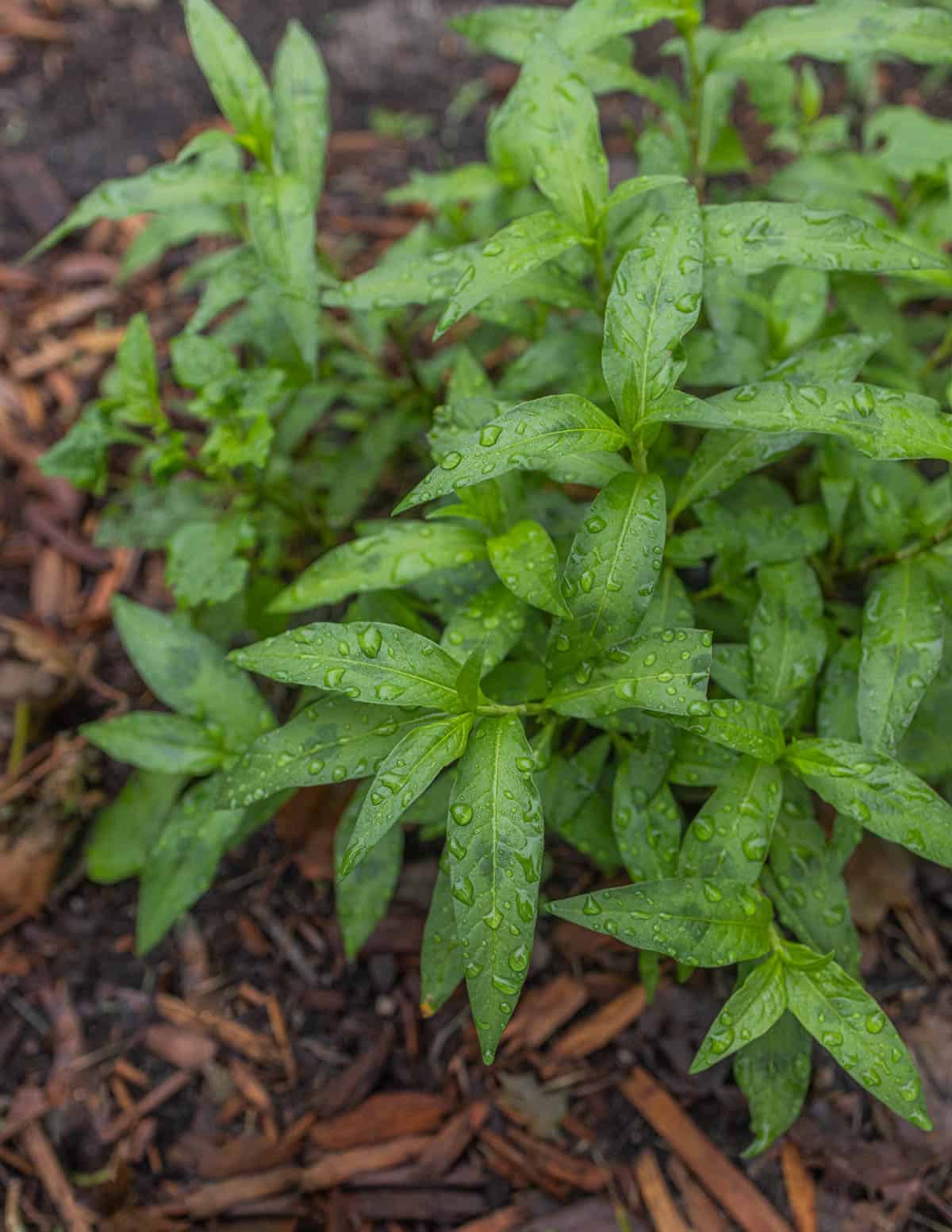
Where the soil is rich and wet, I often see them sprawling out, covering lots of ground. But, in tight quarters like alleys or places with competition from other plants they may grow vertically / erect instead.
General Cooking
Lady's thumb and other smartweeds I've had are mild tasting with a subtle green bean taste that reminds me of dock leaves without the tartness or mucilage, although they will be gently slippery after cooking. Some claim it has a spicy flavor which could come from people confusing the plant with waterpepper.
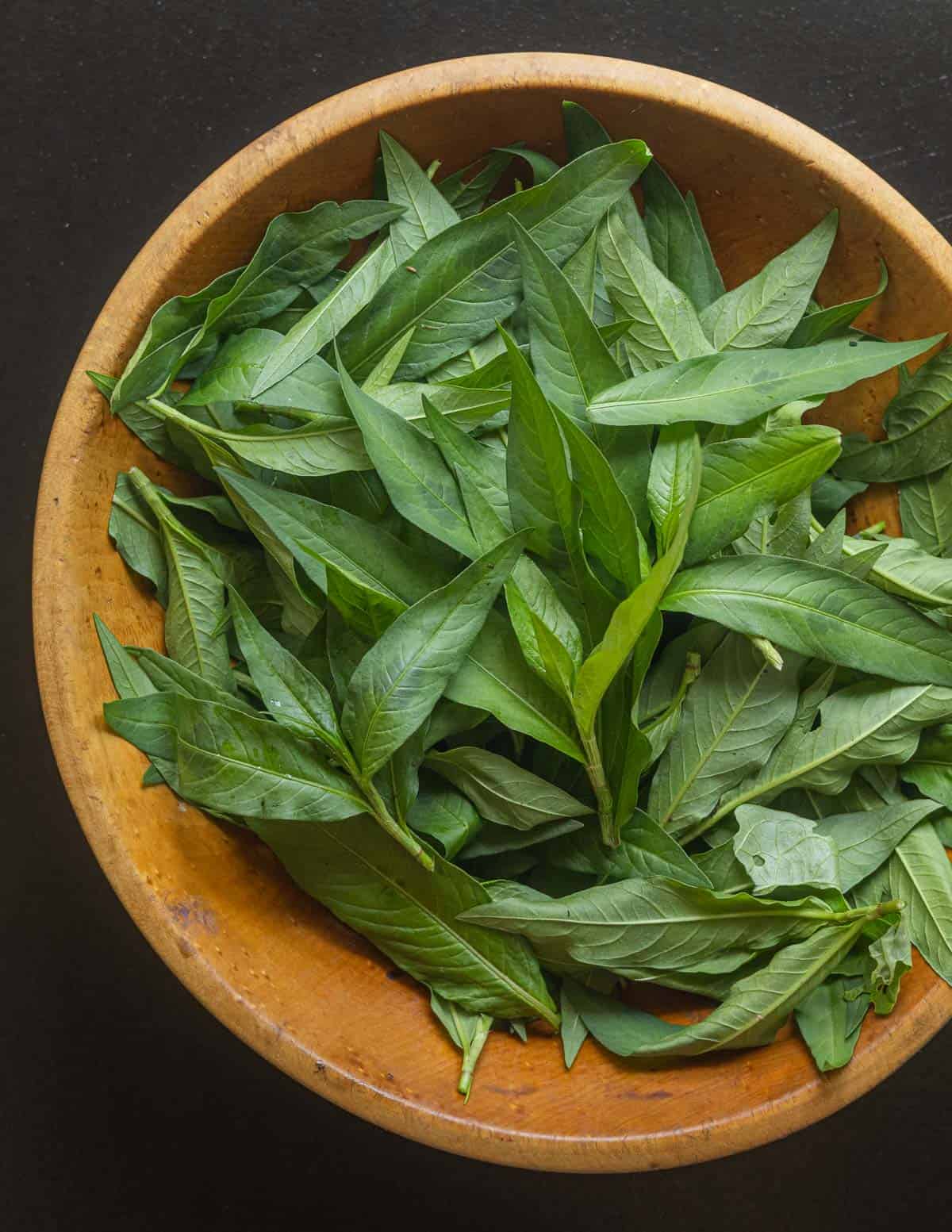
The meristematic parts of the plant (young and tender) are what's harvested for cooking. Generally, these will be tender tips and leaf clusters a few inches long. Pinch the tips from the plants or cut them with a scissors. Refreshed in cold water, spun dry and refrigerated the greens have stayed fresh for up to three weeks for me.
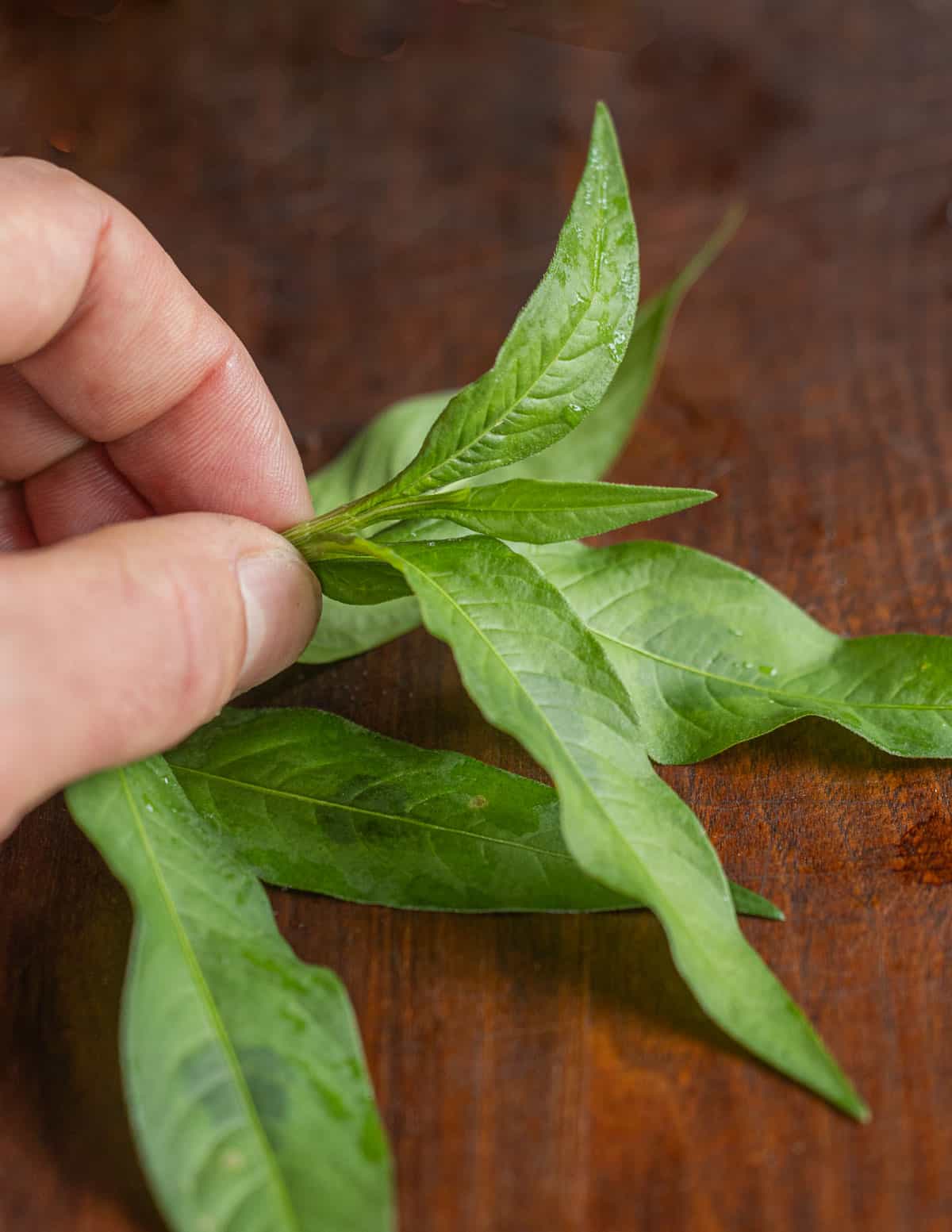
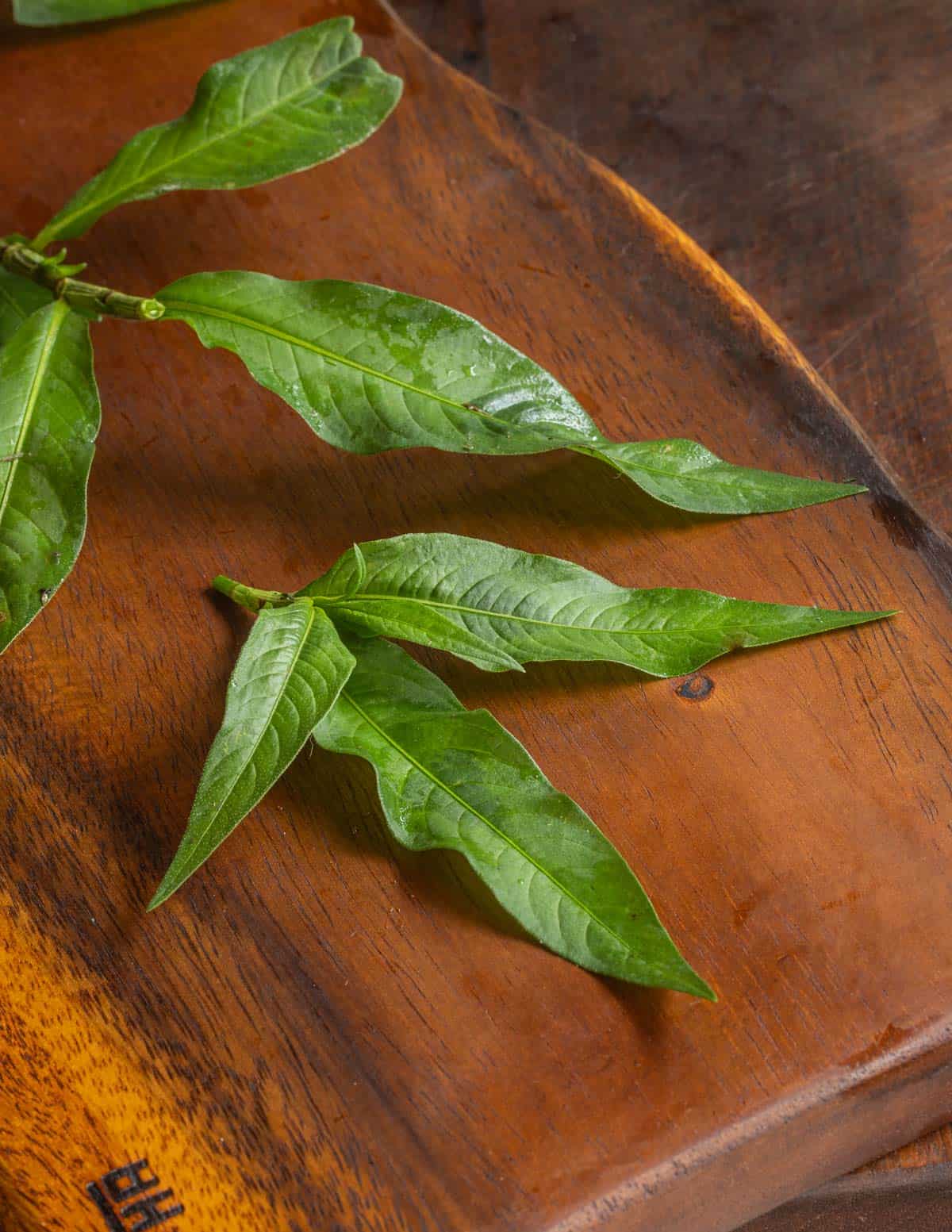
Smartweeds can be tough raw and are best cooked. Chopped leaves can be added to soups and cooked rice dishes or any other place you'd use mild leafy greens. I think the best way to cook them the first time is simply boiled quickly until just tender and served with soft butter and a pinch of salt.
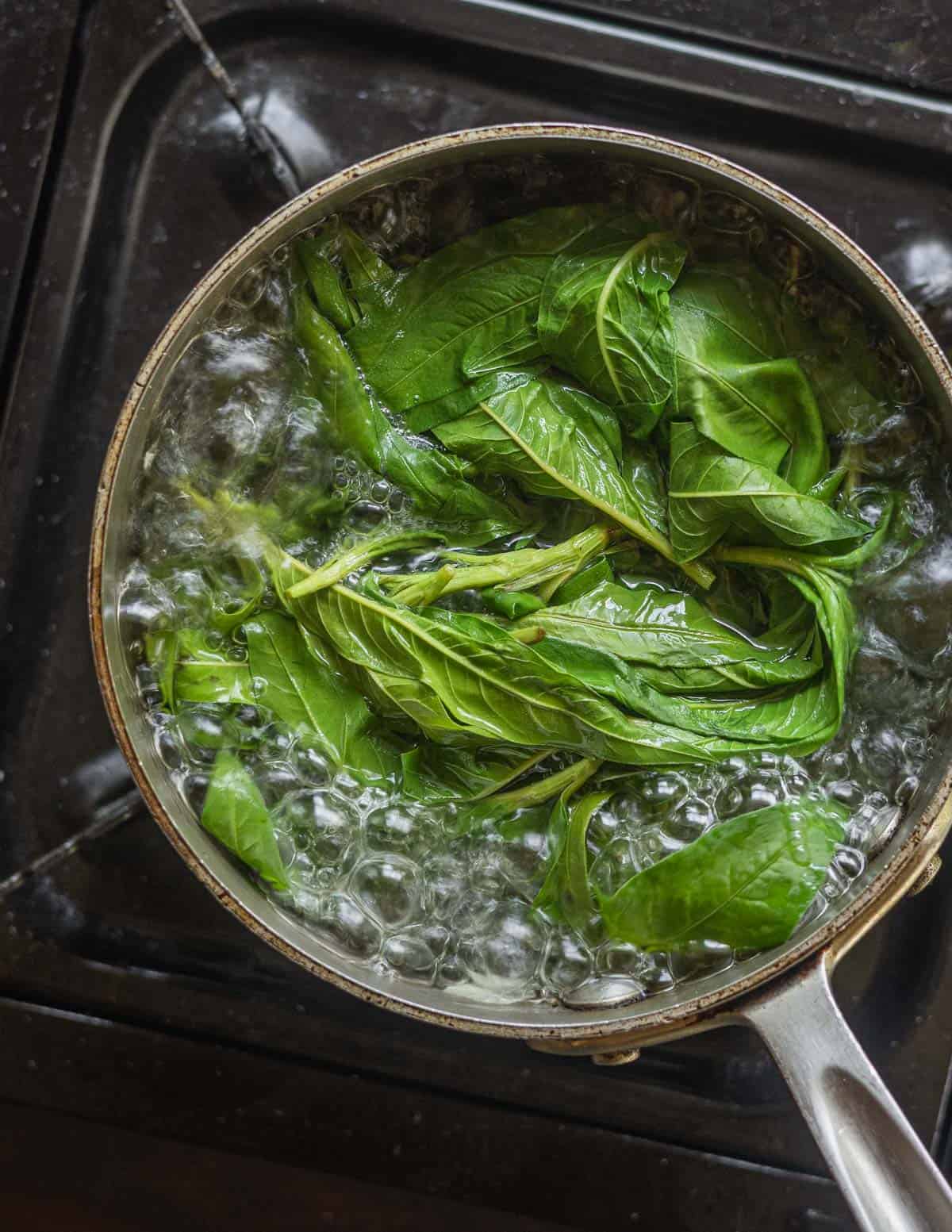
Some sources suggest boiling the greens for five minutes which will give you overcooked mush. Harvested at a tender, meristematic stage, quickly boiled until just tender (1-2 minutes) is perfect.
Older ones I've had can be slightly astringent, but nothing cooking them in a blend of other leafy greens can't fix. They're lovely in a blend of summer wild plants like sow thistle, black nightshade, and galinsoga, pictured below in my basket below.
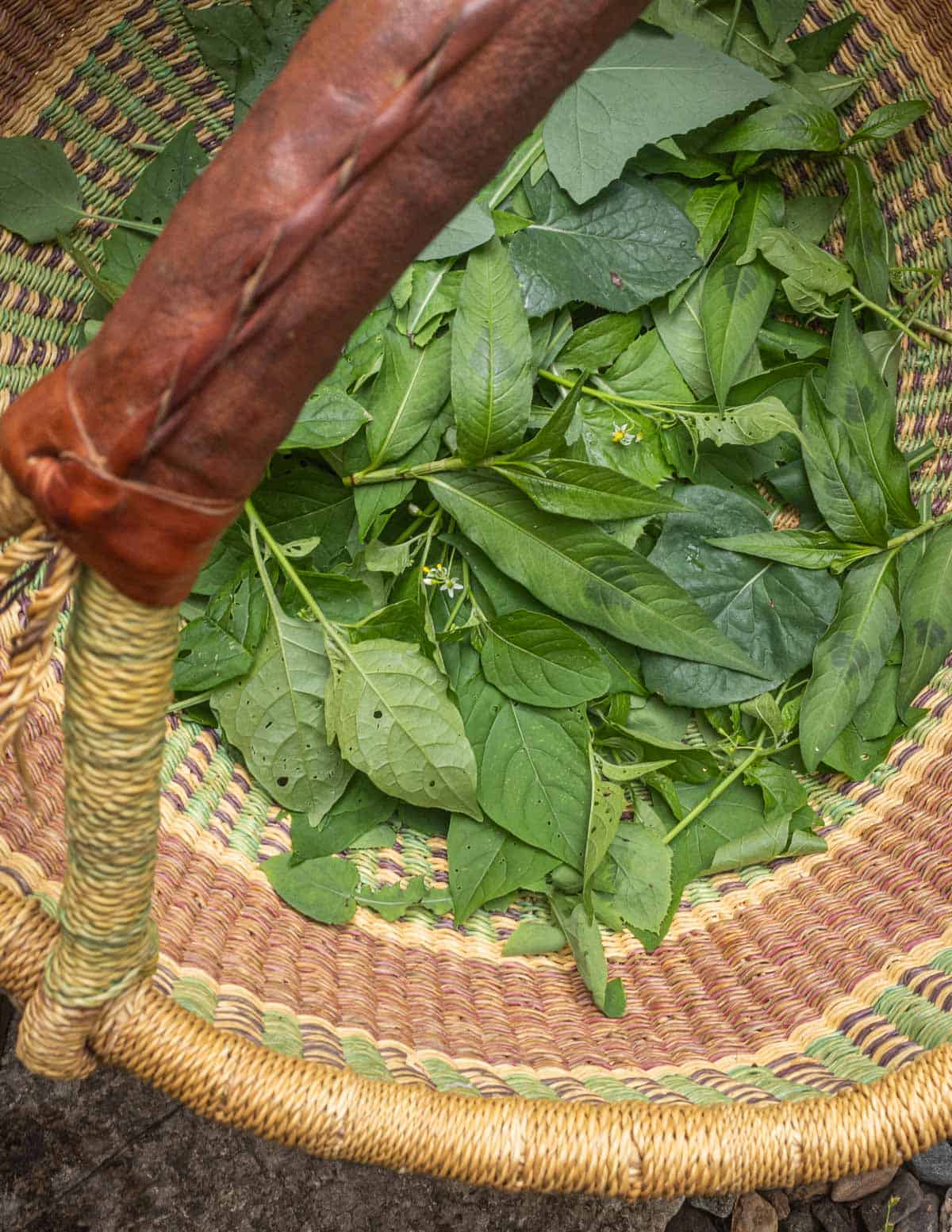
Smartweed seeds, while edible, are hardly worth gathering unless you want to propagate them. Unlike waterpepper they're pretty bland and not very exciting, especially considering the greens can be harvested in good quantity.
Lady's Thumb Recipes
While any of the smartweeds I've had aren't the equal of, say, lambs quarters, amaranth or nettles, their mild flavor and texture is good in dishes of mixed leafy greens where they can mellow the taste of plants with strong or bitter flavors.
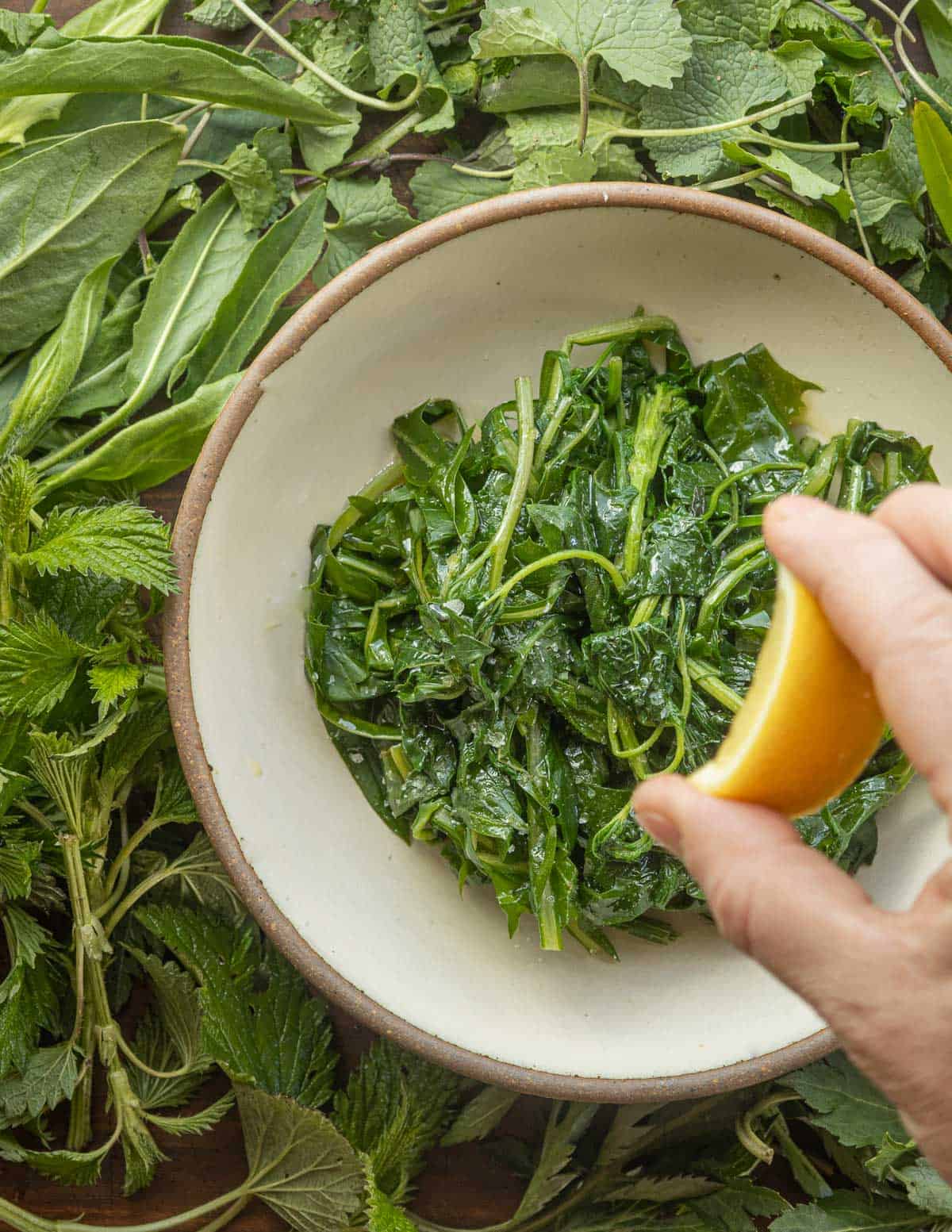
Since they taste mild, garlic, onions, hot chilis, soy sauce can add some character to them, but smartweed greens are also fine used in a simple dish of boiled plants with lemon and oil like Greek Horta pictured above. And, of course you can always add them to Green Burgers / Spinach Patties.
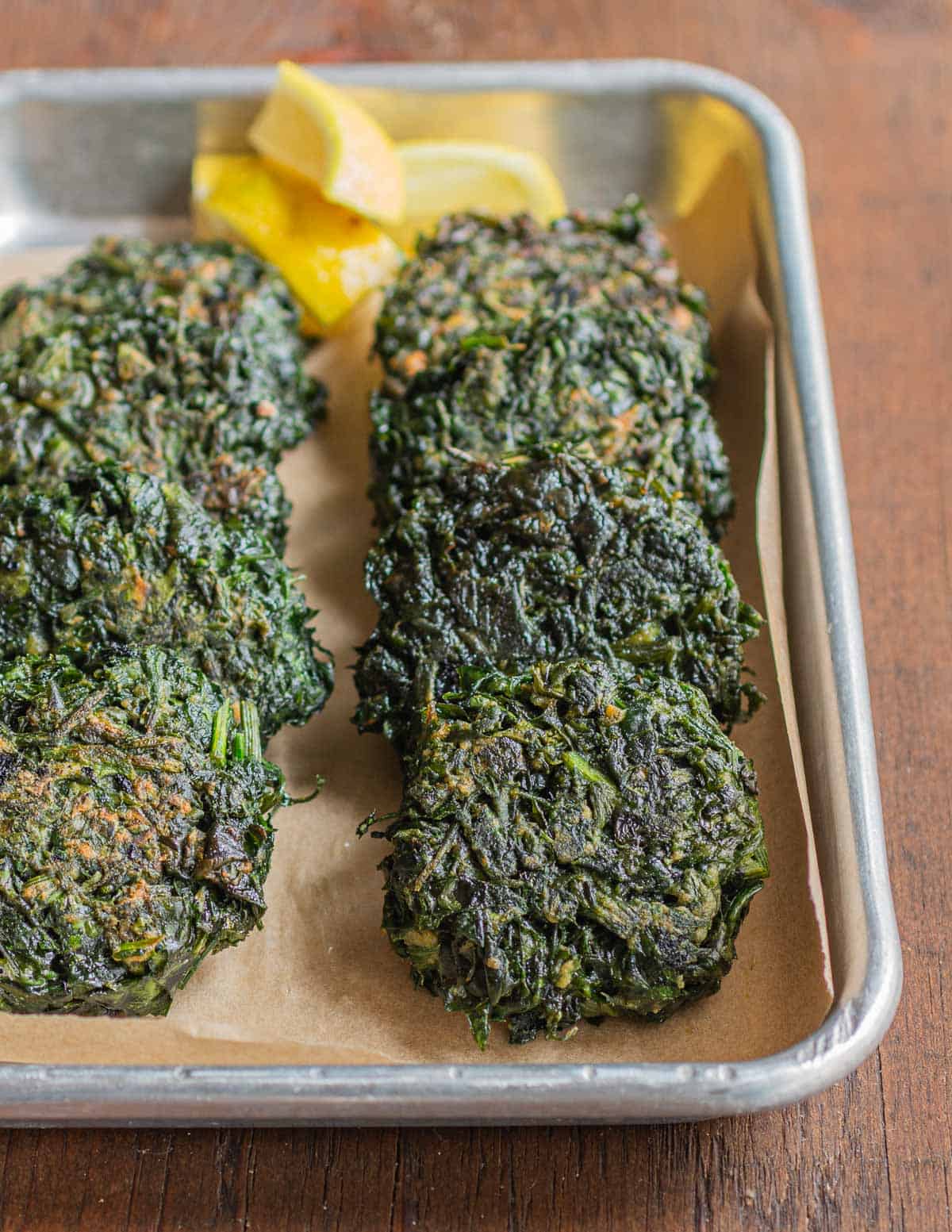
Another recipe I could eat every day is mixed greens cooked with garlic and chili-the classic Italian Ciccoria en Padella. Go outside with a scissors just before dinner, grab all the edible weeds you can find and give it a try.
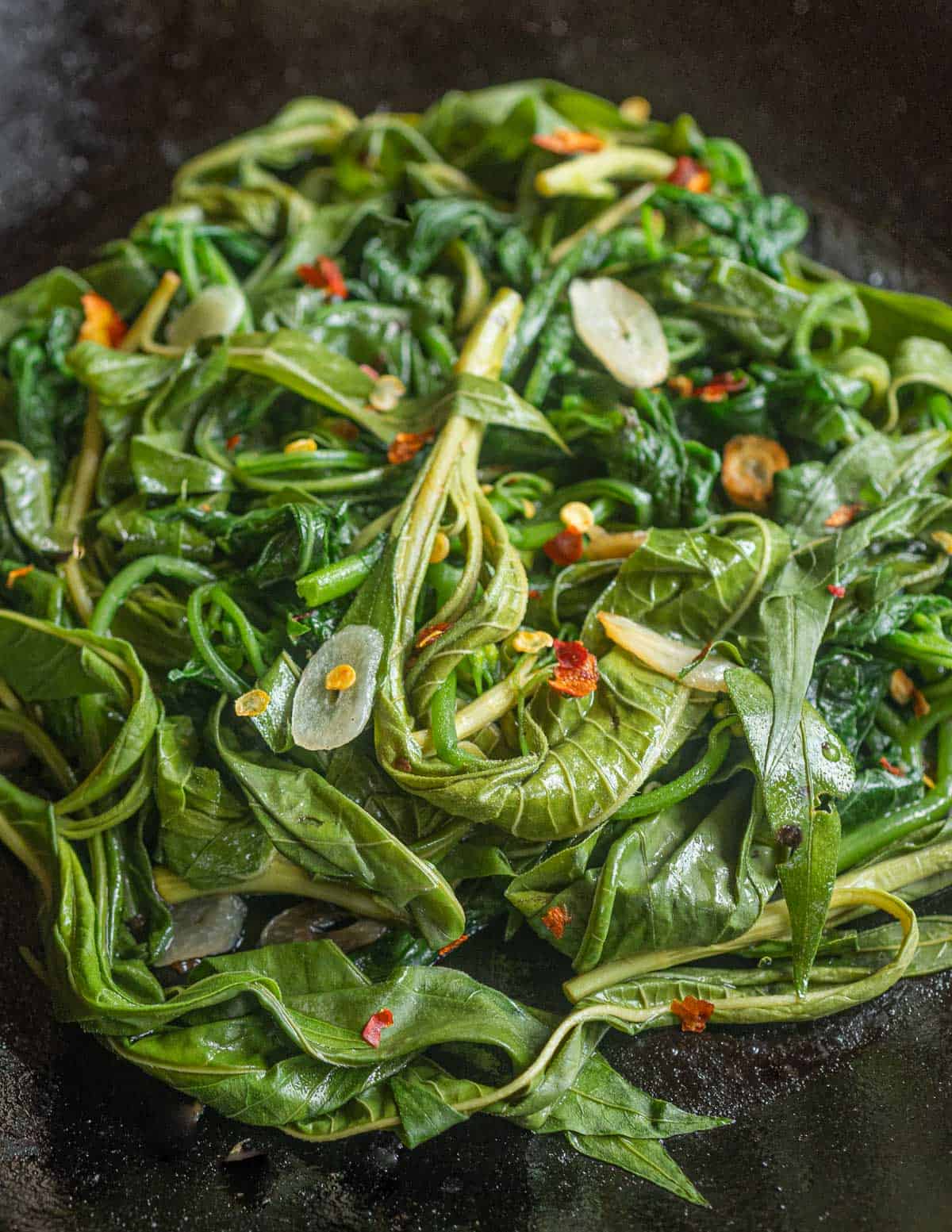
An elegant, simple way to eat the greens by themselves is a Japanese gomae salad. The plants are quickly boiled until tender, chilled and dressed with a mixture of crushed sesame seeds or other nuts (I use black walnuts) soy sauce, mirin or a splash of vinegar and maple syrup.
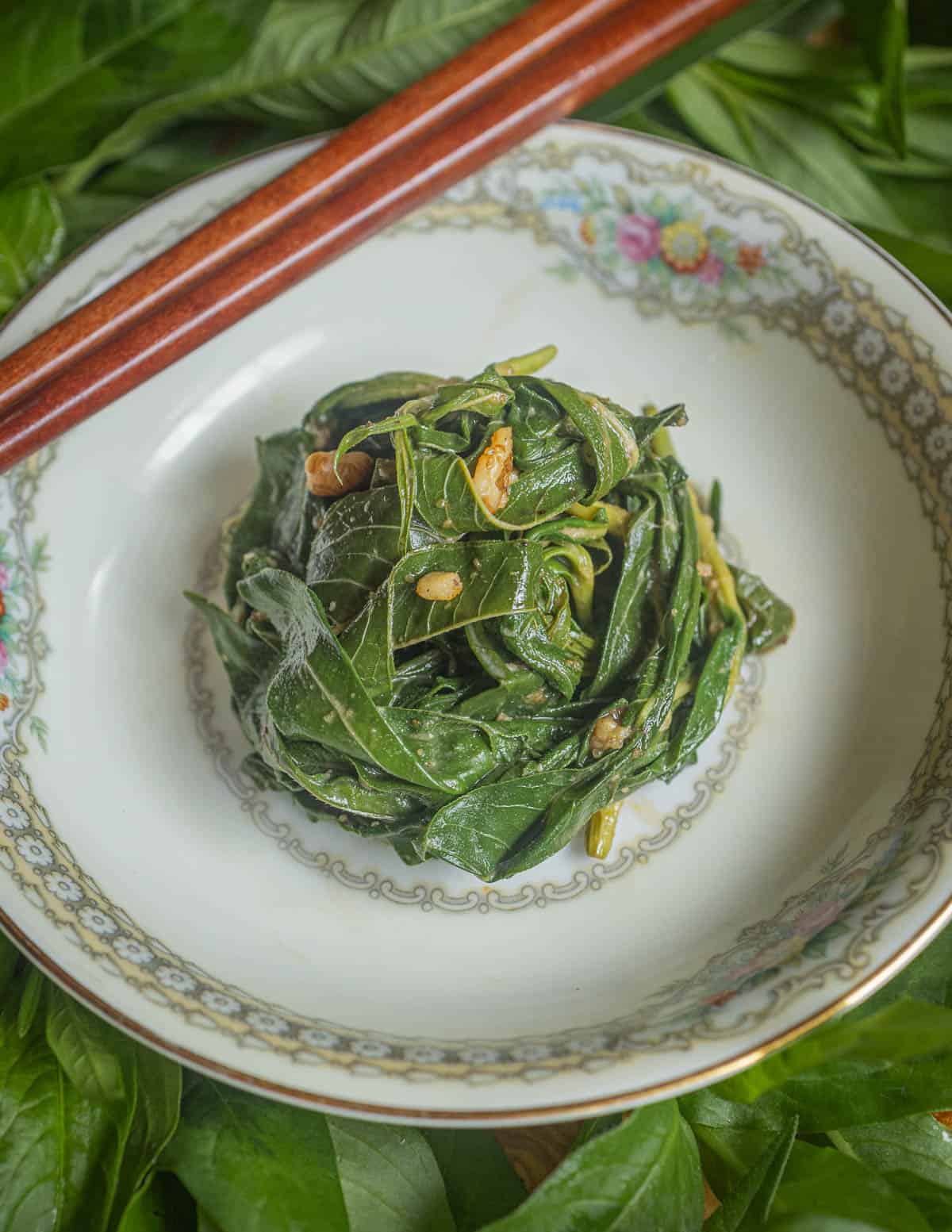
I demonstrate the gomae recipe in the video below. You can use my Violet Greens Gomae as a starting point.

Terry Allaway
Have seen this plant popping up recently in the nursery and other places, now know what it is and am looking forward to not just putting her in the compost. Love all the new things I learn on your blog and always looking forward to your posts!
Alan Bergo
Hey thanks Terry.
Linda Lee
This post was perfect timing as I have just started seeing this plant in my community garden. I hadn't considered it edible before! So I harvested some this morning and briefly blanched it in salt water. Their slippery texture and taste reminds me of okra. I'll be adding this green to the others I've already been picking - nettles, amaranth, lambsquarters and purslane, all from the community garden. Free, wild food!
Joe
Thank you for sharing this Alan. I live in South Eastern Georgia along the Canoochee River and have seen these all my life but never considered them as a wild edible. I will have to try them. Your kitchen is cool by the way.
Alan Bergo
Hey thanks Joe. I like seeing these plants on my property.